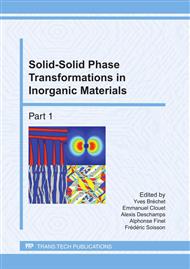p.166
p.172
p.178
p.184
p.190
p.196
p.202
p.208
p.214
Effects of Cooling Rate and Sn Addition on the Microstructure of Ti-Nb-Sn Alloys
Abstract:
Ti-based alloys present unique properties and hence, are employed in several industrial segments. Among Ti alloys, β type alloys form one of the most versatile classes of materials in relation to processing, microstructure and mechanical properties. It is well known that heat treatment of Ti alloys plays an important role in determining their microstructure and mechanical behavior. The aim of this work is to analyze microstructure and phases formed during cooling of β Ti-Nb-Sn alloy through different cooling rates. Initially, samples of Ti-Nb-Sn system were prepared through arc melting furnace. After, they were subjected to continuous cooling experiments to evaluate conditions for obtaining metastable phases. Microstructure analysis, differential scanning calorimetry and X-ray diffraction were performed in order to evaluate phase transformations. Depending on the cooling rate and composition, α” martensite, ω phase and β phase were obtained. Elastic modulus has been found to decrease as the amount of Sn was increased.
Info:
Periodical:
Pages:
190-195
Citation:
Online since:
June 2011
Price:
Сopyright:
© 2011 Trans Tech Publications Ltd. All Rights Reserved
Share:
Citation:


